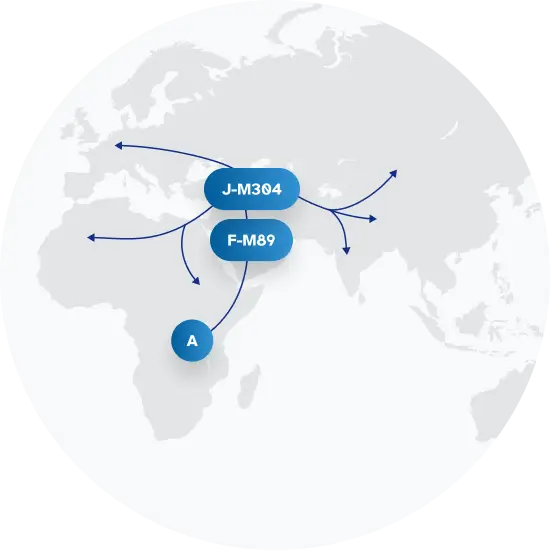Explore the Family Name Salim
How common is the last name Salim in the United States?
Based on data from the Decennial U.S. Census, the surname Salim has seen a rise in popularity between 2000 and 2010. In 2000, Salim was ranked as the 13,989th most popular surname, but by 2010 it had climbed to 12,986th place, showing a 7.17% change in ranking. The count of individuals with this surname also increased during this period, from 1,979 in 2000 to 2,364 in 2010, marking a significant increase of 19.45%. The proportion per 100,000 people rose from 0.73 to 0.8, showing a growth rate of 9.59%.
| 2000 | 2010 | Change | |
|---|---|---|---|
| Rank | #13,989 | #12,986 | 7.17% |
| Count | 1,979 | 2,364 | 19.45% |
| Proportion per 100k | 0.73 | 0.8 | 9.59% |
Race and Ethnicity of people with the last name Salim
Regarding ethnicity, the Decennial U.S. Census data shows that between 2000 and 2010, there were shifts in the ethnic identities associated with the surname Salim. The proportion of individuals identifying as Asian/Pacific Islander rose slightly from 32.69% to 33.63%. However, those reporting two or more races decreased significantly, from 14.3% to 5.88%, a drop of nearly 59%. There was a small increase in the proportion of individuals identifying as White (from 34.31% to 37.1%) and Hispanic (from 4.35% to 4.57%). The most noteworthy change was observed among those identifying as Black, which saw an increase from 13.59% to 18.44%, indicating a substantial growth of 35.69%. Conversely, the percentage of American Indian and Alaskan Native decreased by half, from 0.76% to 0.38%.
| 2000 | 2010 | Change | |
|---|---|---|---|
| White | 34.31% | 37.1% | 8.13% |
| Asian/Pacific Islander | 32.69% | 33.63% | 2.88% |
| Black | 13.59% | 18.44% | 35.69% |
| Two or More Races | 14.3% | 5.88% | -58.88% |
| Hispanic | 4.35% | 4.57% | 5.06% |
| American Indian and Alaskan Native | 0.76% | 0.38% | -50% |
Salim ancestry composition
23andMe computes an ancestry breakdown for each customer. People may have ancestry from just one population or they may have ancestry from several populations. The most commonly-observed ancestry found in people with the surname Salim is Northern Indian & Pakistani, which comprises 15.1% of all ancestry found in people with the surname. The next two most common ancestries are Iranian, Caucasian & Mesopotamian (14.5%) and Chinese (12.2%). Additional ancestries include Levantine, British & Irish, Peninsular Arab, Sudanese, and Spanish & Portuguese.
Ready to learn more about your ancestry? Get the most comprehensive ancestry breakdown on the market by taking our DNA test. Shop 23andMe
| ANCESTRY BREAKDOWN | COMPOSITION |
|---|---|
| Northern Indian & Pakistani | 15.1% |
| Iranian, Caucasian & Mesopotamian | 14.5% |
| Chinese | 12.2% |
| Other | 58.2% |

Possible origins of the surname Salim
Your DNA provides clues about where your recent ancestors may have lived. Having many distant relatives in the same location suggests that you may all share common ancestry there. Locations with many distant relatives can also be places where people have migrated recently, such as large cities. If a large number of individuals who share your surname have distant relatives in a specific area, it could indicate a connection between your surname and that location, stemming from either recent ancestral ties or migration.
Based on 23andMe data, people with last name Salim have recent ancestry locations spanning a few countries, mostly in Lebanon, and China.
| RECENT ANCESTRY Location | Percentage |
|---|---|
| South Governorate, Lebanon | 17.20% |
| Mount Lebanon Governorate, Lebanon | 17.20% |
| Beirut Governorate, Lebanon | 17.20% |
| Fujian, China | 17.20% |
| Zhejiang, China | 16.10% |
What Salim haplogroups can tell you
Haplogroups are genetic population groups that share a common ancestor on either your paternal or maternal line. These paternal and maternal haplogroups shed light on your genetic ancestry and help tell the story of your family.
The top paternal haplogroup of people with the surname Salim is J-L26, which is predominantly found among people with European ancestry. Haplogroup J-L26 is descended from haplogroup J-M304. Other common haplogroups include R-Z645 and J-CTS5368, which are predominantly found among people with European and European ancestry. Other surnames with similar common haplogroups are: Habib, Hakim, Abbas, Montgomery, Silberman, Betancourt, Sobel, Ismail, Shaheen, Issa.
The most common maternal haplogroups of people with Salim surname are: M, U2_3_4_7_8_9, H. These most commonly trace back to individuals of European ancestry.
 Paternal Haplogroup Origins J-M304
Paternal Haplogroup Origins J-M304Your maternal lineage may be linked to the ancient people of the Indian subcontinent
While Haplogroup M is widespread throughout South and East Asia, it is more diverse on the Indian sub-continent than anywhere else in the world. The high degree of diversity of M in India is likely tied to its ancient arrival here nearly 50,000 years ago. In addition to M2, which is found throughout the subcontinent, there are dozens of haplogroups branching off of M that exist in India. These branches are often connected to specific regions, tribes, or ethnic groups. For example, haplogroup M18 is found among the Oraon peoples of eastern India and Bangladesh, while haplogroup M41 is common among the Pardhan speakers of eastern India, and haplogroup M31a can be found on the Andaman Islands, just off the southeast coast of India.

What do people with the surname Salim have in common?
Spoiler alert: it's complicated. People with the same last name are usually no more genetically similar than a randomly sampled group of people from the same population. That said, people with the same surname are more likely to have similar ancestries than randomly sampled individuals. The reason is the tendency of people with similar cultural or geographical backgrounds to preferentially mate with one another. That's why people who share a surname may be more likely to share traits and tendencies in common than people within the general population. Check out the percentages below to see the prevalences of tastes, habits, and traits of people with your surname compared with prevalences among 23andMe users.
Preferences
Traits
Habits

Vitamin Use
Takes vitamins on a regular basis.
"Salim" Surname 46.7%
23andMe Users 45.5%
Wellness

Migraine
A severe headache characterized by intense pain, sensitivity to light and sound, and often accompanied by nausea and vomiting.
"Salim" Surname 7.1%
23andMe Users 16.4%
Are health conditions linked to the last name Salim?
The short answer is that, if there is an association between surname and health, it's usually more about your ancestry than your name. Individuals with a given surname are no more genetically similar than the general population but often have similar ancestries. The populations of people associated with those shared ancestries often have sets of genetic variations, also known as alleles, in common. Some of those alleles are associated with a greater likelihood of developing certain diseases.
Disease variant frequency by ancestry
Disease allele frequencies in populations associated with the surname Salim are shown below. Important Note: not everyone with a disease allele will develop these health condition







